Preface.
Much has been written about the Pirates of the Caribbean, literary and colorful and written by such masters as Daniel Defoe and Robert Lewis Stevenson. And, of course, by their many colleagues, at different times. But the most exciting tales of piracy were written by the gentlemen of fortune themselves. One of these was Captain Charles Johnson, whose book was published in London in 1724. Displayed in a shop window, the little book would not have attracted the attention of the casual passer-by had it not been for its title: “A Complete History of the Robberies and Murders Committed by the Most Dreadful Pirates of the New World”. And readers jumped at it. The common man loves a gory tale.
Nobody knew this Captain Johnson, not even the publishers of his book, which became an instant bestseller and inspired many adventure writers over the centuries. Even today, scholars continue to speculate about who the author of this book was. Most experts agree that he was a pirate himself. After all, to write in such detail about the bloody deeds of pirates could only have been done by someone who was one of them. Obviously, for reasons of personal safety, the author preferred to hide behind an assumed name.
People still write about pirates. Probably because piracy has not disappeared, it reminds us of itself from time to time. I offer a series of stories from my book on the pirates of the Caribbean and Indian Ocean. In them, I have added findings from archives and stories from the descendants of the pirates among whom I live. Their great-grandfathers pirated under the flags of those whose names have come down to us. Such stories can only be heard over a glass of spiced rum in a fisherman’s tavern…
===== ===== =====
1.ROCK BRAZILIAN.
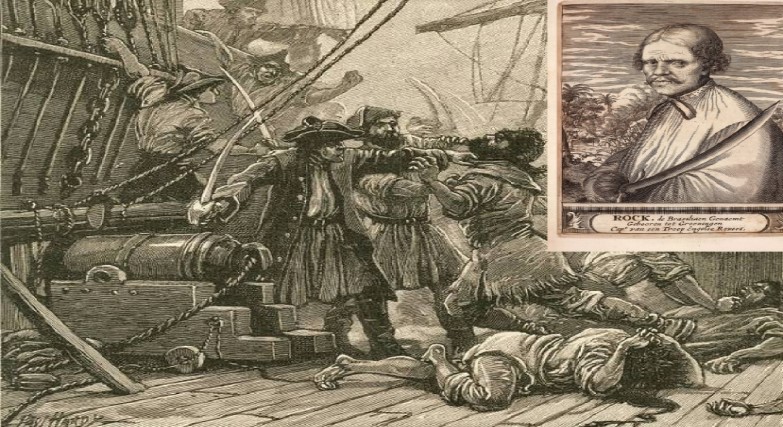
Born in Holland in 1630, his name was Gerrit Gerritson. As a teenager, he signed on a ship and sailed to Brazil. There he spent ten years as a pirate for the French, who called him Roche. In 1654 the Portuguese began to restore order to their colony, kicking out the French and Dutch. And Roche moved to the Caribbean island of Jamaica, where piracy was in full bloom. Our hero’s mastery of all sorts of weapons, including the Indian bow, made him much in demand. There he was nicknamed ‘Rock Brazilian’.
At first, he took a job on a merchant ship under the command of Captain Van Diemen. At sea, Rock had partners and at the first port, they escaped. They found a small schooner and set out as pirates, choosing Rock as their captain. They were lucky enough to capture a Spanish carrack full of silver in the hold. Brazilian immediately became popular in Jamaica.
He was also known for his debauchery when he would buy a barrel of wine, roll it out into the street, pop the cork, and sit down next to it with a sword in his hand. If anyone refused to drink with him, the Brazilian would threaten to shoot or cut them down. The Brazilian plundered Spanish settlements and was known for his cruelty. He once roasted two of the fattest prisoners alive on spits because they refused to reveal the location of their pig farm. He was an utter degenerate and sadist, not without vanity, so he exhibited vices to assert his authority.
In the Mexican waters of the Gulf of Campeche, their schooner was blown onto the rocks by a storm. Three dozen pirates made it ashore and managed to salvage their weapons. They wandered about in search of food when they were attacked by mounted Spaniards. The odds were against them, but the pirates fought back and every bullet from their muskets found its target. The surviving Spaniards fled, and the pirates seized the horses and weapons of the dead.
Then they moved up the coast and after a few days came across some loggers loading their barge with redwood. The pirates waited until almost all the workers had gone into the thicket and stole their ship. They took the barge to Jamaica, eating all the horses along the way. They encountered a Spanish trading ship at sea, and Rock had a plan. Seeing the ship loaded with timber and flying the Spanish flag, the Spaniards, not expecting a catch, allowed the barge to approach. The pirates seized the ship in a boarding battle. They found a rich booty in the hold – chests of silver and lots of goodies. In Jamaica, they had left all their booty in taverns and brothels. Prostitutes who wave their skirts are always richer than those who wave their sabers. It is said that one tipsy pirate paid 500 silver coins just to have a girl undress in front of him. In those days, a good house with land for a farm was worth half that…
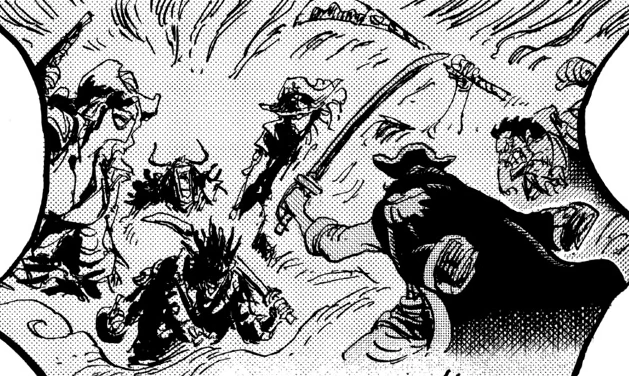
After emptying their pockets in brothels, they sailed back to the Bay of Campeche, where Spanish ships were full of goods plundered from the colonies. For weeks the pirates circled there in vain, and one day a Brazilian with a dozen thugs went ashore in search of food. The Spanish tracked them down, captured them, and threw Rock into a pit. Under torture, he revealed the location of the treasure he had buried on an island off Cuba. The local governor wanted to hang the Brazilian, but the pirate was more cunning. He wrote an ultimatum, supposedly from the pirates of Jamaica, which was delivered to the governor by a third man. The letter said that if the Brazilian was hanged, the captured Spaniards would suffer the same fate without mercy. The blackmail worked. The governor took a written oath from the pirate that he would never return to his bloody trade, and if he broke his oath and was captured, he would be executed on the spot. The pirate’s confession was sent to Jamaica and read to a large crowd. The governor sent the prisoner on a caravan of ships bound for Spain.
On a sea voyage lasting several months, the resourceful pirate collected flying fish on deck at night and used them as bait to catch larger fish. Selling his fresh catch to the crew Rock earned some money, which came in handy later on. When the ship reached Spain, the pirate escaped and fled to France. In one of the ports, he bought clothes and false papers, boarded an English ship, and returned to Jamaica. There he bought a brigantine armed with cannons from the pirate and sadist Olone and continued his piracy. He even took part in the raids of the legendary admiral of all pirates, privateer Henry Morgan. Of course, the Brazilian was as bloody as ever. His career as a pirate was the longest, lasting almost twenty years.
In the 17th century, Europe’s monarchs were preoccupied with more important matters: dividing up the captured lands of the New World. They were pirates themselves, and bandits like Rock Brazilian were considered small fry, not worthy of their attention. But these monarchs soon realized that the pirates had given their vassals a taste for anarchy and freedom. So they put aside differences between themselves and declared war on all pirates.
In 1671 there was a rumor in Jamaica that Rock Brazilian had been stabbed to death in a street fight. Whether it was true or not, no one has heard from him since.
Meanwhile, in modern Brazil, they commemorated the pirate “Roche Brazilian” by launching a brand of pipe tobacco with his name on the box. What would that mean?
There is always an unstable society, with more drunks, thieves, rapists, and bums than decent people. They make up the majority of the electorate. Sophisticated politicians know this, and in preparation for elections, they give gifts to their voters.
===== =====
2. CANNIBAL D’OLONE.
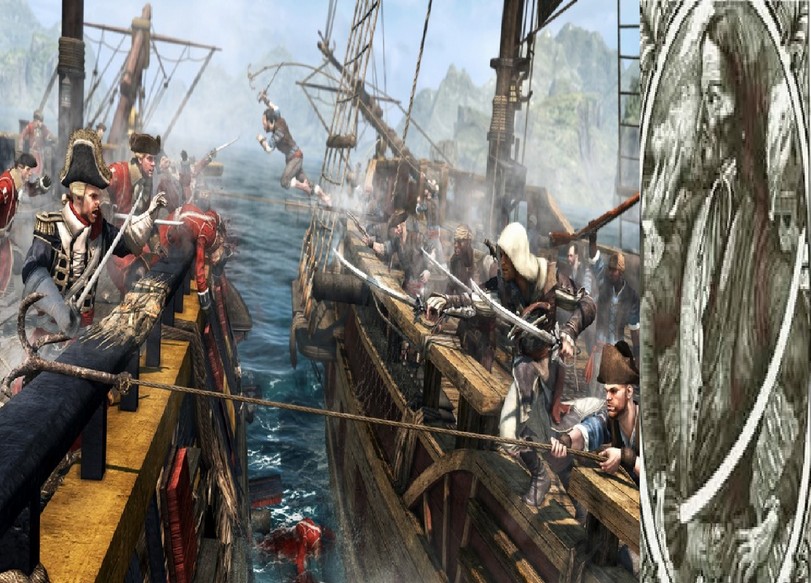
Jean Nau (or François) was born in 1635 to a poor family in the port of Les Sables in the province of d’Olonne on the Bay of Biscay. At that time, recruiters were on the prowl throughout Europe, luring gullible young men with promises of riches in the New World. Fifteen-year-old Jean found himself in the New World, on the Caribbean island of Martinique.
The reality was far from what the recruiter had described. The plantation owner ruthlessly exploited indentured laborers, whose lives were far worse than those of black slaves. The owner pitied the slave, considering him his property, because he had paid money for him. So he did not wear him out and fed him the way they feed dogs that do their work for food. The plantation owner tried to squeeze all the juices out of the hired laborer before the end of the contract. He could even kill him for disobedience. It happened, and the cruelty went unpunished.
Those who had been enslaved and fled from their masters were hunted down by armed bands, and only pirates could save them. Jean escaped to the buccaneers on the island of Tortuga. There he was nicknamed “Olone”, after the area where he was born.
During the pirate raids, Olone showed the qualities of an ambitious leader and was soon given command of a small schooner. He plundered every Spanish ship he could catch and was ruthless with his captives. In the settlements of the New World the rumour of a cruel pirate who left no one alive…
One day his schooner hit a reef in the Gulf of Mexico. The crew escaped, but a group of Spanish cavalry was waiting for the pirates on the shore. All were shot, and Olone, wounded in the leg, pretended to be dead and hid among the corpses. Hunger drove him to the settlements, where he stole food and clothing. On a plantation, Olone met several slaves and encouraged them to escape. At night they stole a sailing boat, and the pirate took it to Tortuga.
There Olone took possession of a small schooner and together with two dozen robbers went to the coast of Cuba. There they were spotted by local peasants, who reported them to Havana. The governor sent a ten-gun ship with a hundred armed soldiers on board. The captain was ordered to capture the pirates alive and bring them to Havana for public execution. What happened next was this.
OFF THE COAST OF CUBA.

Pirates seized a fishing boat in coastal waters. They learned from the fishermen that a ship from Havana was in the bay of Los Cayos. Olone ordered the captives to take his schooner into the bay where the ship was. The pirates towed the fishing boat behind the stern of the schooner. The Olone’s plan matured.
They hid their schooner in a coastal thicket, and on a fishing boat sneaked into the bay under cover of darkness. As they approached the ship at anchor, they exchanged greetings with the guards, disguised themselves as fishermen, and expressed their desire to stay the night under the warship’s protection.
Soon a veil of rain covered the bay, and taking advantage of it, the thugs climbed aboard of the ship. Chopping up some of the crew, the pirates forced the rest into the hold and locked them up. The ship left the harbor and Olone ordered to free the fishermen.
The damp morning breeze was filling the sails and the ship raced away from the misty shore. The pirates carried food and wine on deck. A little monkey huddled in a corner of the captain’s cabin, staring in horror at the aliens.
“Captain, what to do with the prisoners?”
“Dead cats don’t meow, ” Olone grinned.
“There are some important senores, and them too?” The bosun made a characteristic gesture with his hand across his neck.
“No,” grinned Olone, “those we’ll let go”.
“Hey, boy!” He turned his head to the helmsman, “we’re going to drift.” In a minute the sails sagged, and the pirates quickly tied them to the mast.
“Get those important turkeys over here, bosun!” Olone sat on the rope smoking his pipe, “and whistle all hands on deck! Hoyay, that we die!”
The pirates dragged on deck several bodies in bloody camisoles. The poor men could hardly stand on their feet.
“I see you have not been well fed…” Olone shook his head, “But now this ship is mine, and you will be fed meat!”
“Hey, cook!” Olone shouted, his eyes bloodshot, “Feed these wretches, get the monkey!”
The laughing pirates huddled together, and the show began. The monkey screamed wildly and cowered, foreseeing his end. With a swipe of his saber, Olone cut off its head and chopped the carcass into pieces. The animal’s blood splattered on the deck.
“Dinner is served, señores.” Olone smiled crookedly and bowed jokingly to the captives. They huddled together, neither dead nor alive.
“We honor the King of Spain and his subjects,” the pirate continued, “But your monarch is very bloodthirsty and has declared war on us. And we are good sailors,” he grinned, “And we’re letting you go home!”
“Hey, bosun, gangway overboard!” Olone ordered. The order was promptly obeyed.
“Well, go, go home, what are you waiting for? Don’t make my companions sin, the sabers are already scratching their hands!” he puffed his pipe angrily. The pirates made faces and moved toward the prisoners, waving their sabers.
The condemned victims jumped overboard, hoping for Providence.
“You forgot your provisions!” laughed Olone from the deck, “Refresh yourselves on the way!” The bloody remains of a monkey flew into the water.
“And for us hungry men, a barrel of wine!” The pirates howled with delight.
“Bring out the others one by one!” Olone tapped his bloody saber on his boot, “And double the wine for the one who beheads with one blow!”
The decapitated bodies were thrown overboard. Soon the fins of sea scavengers showed themselves. The wild screams of the living being devoured by the sharks mingled with the drunken laughter of the pirates. The spectacle was over, the sun was at its zenith. They unfurled the sails, and the ship set course for Tortuga.
Olone left alive one of the prisoners. He furnished him with a letter to the governor of Havana, informing in it that he would spare no Spanish prisoner. The pirate promised that he would hang the governor if he attempted to hang him. The skiff was lowered overboard, and the happy man, stunned by the gift of freedom, grasped the oars.
***
RAID TO VENEZUELA.
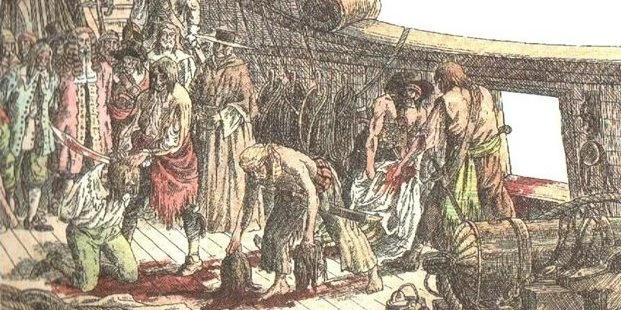
Back in Tortuga, Olone announced an expedition to the Venezuelan coast to plunder the Spanish settlements in Maracaibo Bay. Four hundred pirates immediately signed up. Among them was the famous pirate Michel de Basque. He had plundered enough and, to keep himself entertained appointed himself mayor of the island’s main village. But he was bored, and Olone’s offer seemed tempting. The Basque, who had pirate blood in his veins, agreed to join the raid and provided the new admiral with his ships and three hundred of his men.
Early in the summer of 1667, their eight ships set sail. In the waters off the island of Puerto Rico, they captured a 16-gun Spanish ship carrying 120,000 pounds of cocoa. In the captain’s cabin, they found a chest containing 40,000 silver pesos and jewelry worth another 10,000 pesos. Not a bad start! The captured ship was sent to Tortuga, where the governor, delighted with the booty, loaded it with provisions and returned it to the admiral with a hundred more pirates.
They captured another ship full of war supplies. This time the booty was seven thousand pounds of gunpowder, a mountain of muskets, and 12,000 silver coins. Now ten ships were under Olone’s command, with eight hundred men on board. The pirates were singing songs and sharpening their sabers. The fleet set sail for Maracaibo.
Venezuela’s coastline is dotted with bays. To the south of the island of Aruba, the waters of Maracaibo Bay begin, and at its entrance, dangerous reefs await ships. In the bay lies a passage to a vast lagoon, 180 miles long and 90 miles wide. Of the settlements built by the Spanish along its shores, the largest were Maracaibo and Gibraltar. The passage to the lagoon was narrow and with shallows, and was guarded by the cannons of El Fuerte Fort, capable of destroying the ship of any uninvited foreigner by the crossfire.
Hidden behind the island’s rocks, the pirate ships waited for night. At the council, Olone briefed all the captains on the plan of attack. The Basque had been here before and knew the passages between the shoals and the Spanish fortifications.
By dusk, they were in the bay. In the pitch darkness of the tropical night, their ships crept towards their target. All the topsails on the masts were retracted so that the Spaniards would not see the visitors.
A few miles from the entrance to the lagoon, two hundred pirates jumped into their canoes and headed for the shore. They left their boats on a sandy beach and walked towards the fort, flanking it from the rear. Ready to attack they signaled to the ships with a lighted torch.
The pirates attacked Maracaibo. But the settlement was abandoned, the inhabitants fleeing into the forest, taking all their valuables. The houses were full of food and drink, cows mooing and chickens clucking in their coops. The pirates camped in the best houses and, with sentries on the roofs, made a feast.
The next day, Olone sent out a party to search for the fugitives. By the end of the day, the pirates had brought two dozen villagers and several mules loaded with goods from the forest. Their leader approached the huddled captives in menacing silence. Suddenly, he drew his sabre and, with one swift movement, cut off the head of one of them.
“I will do this to each of you unless you bring back everything you’ve hidden!” Olone shouted. His bulging eyes were swollen with veins, and foam flew from his mouth. For two weeks, the pirates fished out the fugitives, and the mountain of booty grew. But the pirates did not have it enough and decided to march on Gibraltar.
There the governor prepared to defend the village. A battery of twenty cannons was placed on the approaches to the settlement, redoubts were built, and rubble and traps were prepared. Eight hundred men were recruited from the community.
The pirate ships anchored a mile off the coast of Gibraltar. Olone led a force of four hundred men. He lined them up on the shore in a marching column and brandished his saber:
“Let fearlessness be with us! Anyone who shows cowardice, I will shoot myself!” Olone grinned wryly. The pirates swore allegiance to one another.
The defenders of the city met them with cannon fire. Two dozen pirates were killed in the first volley. The buccaneers responded with their tried and tested tactics, firing at the artillerymen. Soon the cannons fell silent and the pirate sabers went into action. Five hundred defenders were killed and hundreds of men, women, and children were taken prisoners. The pirates lost forty dead and thirty wounded. After burying their dead, they loaded the bodies of the killed Spaniards onto old barges and sank them in the lake.
The pirates were sacking Gibraltar for a month. They hunted for booty in the surrounding forests and brutally tortured the prisoners, demanding hidden goods. Hands were cut off, tongues torn out and eyes gouged out. Many died of torture and exhaustion. The women survived, fed by the pirates, and left to their carnal pleasures. Messengers were sent to neighboring settlements to demand ransom. If not paid, the pirates threatened to burn Gibraltar to the ground. After receiving the ransom they loaded their ships with loot and prisoners, and left.
The booty was enormous, amounting to a quarter of a million silver pesos, many household utensils, and slaves. In Tortuga, all the loot was drunk, gambled away, and given to prostitutes.
***
MADAME FORTUNE DOESN’T ALWAYS SHOW HER TITS.
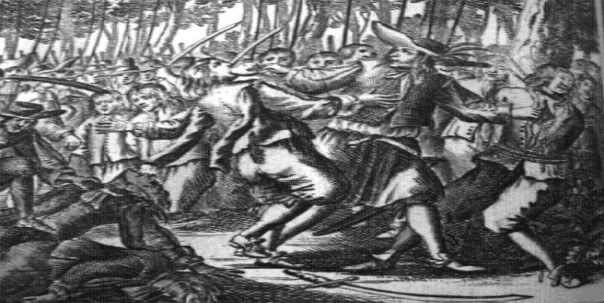
In the early spring of the following year, 1668, Olone decided to raid the Spanish settlement of Puerto de Cortes (now Puerto de Cabayos) in Honduras. Gathering 700 bandits and equipping six ships was not difficult. But if the previous expedition had been successful, they now faced the problem of supplying the expedition with provisions. The overconfident Ohlone decided to take the supplies from the Spaniards on the spot, and his fleet left Tortuga.
They entered an empty town. The Spaniards fled, destroying the supplies. Olone was furious; he tore the unfortunate prisoners to pieces and demanded to know where the gold and supplies were hidden. In a fit of rage, he cut open one prisoner’s chest, ripped out his heart gnawed on the throbbing flesh, and then shoved the heart into another prisoner’s mouth, threatening to do the same to all of them. Sadistic and psychotic, he growled as a wild beast. It was all for nothing, there was no gold or silver. Most importantly, there was no food.
His army began to disperse, leaving Olone with one ship and three hundred pirates. They learned from their victims that a ship from Spain would soon arrive, laden with goods. Their schooner needed repairs and the pirate took the ship deep into the Gulf of Honduras.
In the shallow waters of one of the islands, locals collected bees’ nests, brought from the mainland by the current. Those honeycombs were full of honey and wax. Locals used the wax to treat wounds and make candles, and the honey to treat internal diseases. The pirates mixed beeswax with boiling shark oil to soak the bottom of their schooner.
Soon they got the news that a ship had arrived from Spain. Olone hoisted the sails, and on the third night, the pirates were there. They broke into the harbor but found only empty wine casks on board the captured ship. The Spaniards had managed to get all the cargo out, which was already far away. Olone was furious: his expedition had failed. He decided to look for booty at sea.
But failure continued to haunt him. In the waters between Honduras and Guatemala, his schooner hit the reefs of Las Perlas. Olone decided to use the wreckage of his ship to build a long pirogue to try to capture another vessel. They saved supplies and equipment and began to build the boat on the island.
The small band of pirates continued along the Panamanian coast in a constructed boat. They were ambushed by cannibals in the Gulf of Darien. The pirates were hacked to pieces and dragged to a bonfire. Olone was cut up alive, roasted, and eaten.
Only one escapee survived, and he brought news of what had happened. Of the remaining pirates on the island, many died of disease and the rest were picked up by a passing sailing ship from Jamaica. Thus ended the epic of the most bloodthirsty Caribbean pirate of the XVII century. What he did to others, he had for himself.
© Copyright. Certificate of publication #214070300243
===== =====
4. CHARLES VANE’S PIRATE’S CHEST.
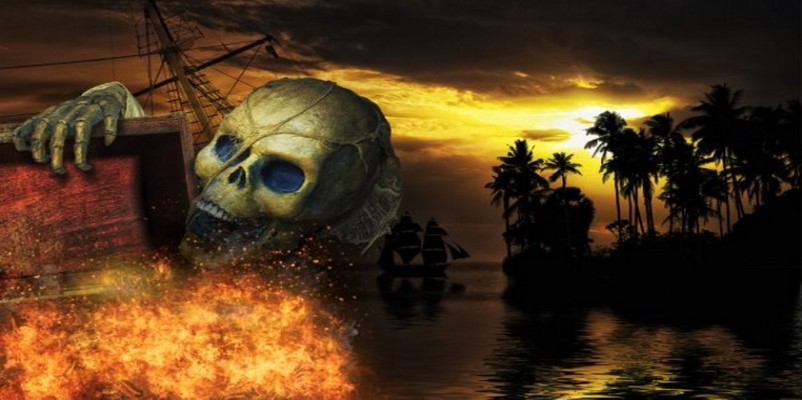
In May 1713, the Treaty of Peace was signed between England and Spain. The news reached Jamaica and all privateer licenses were revoked. The most famous, Henry Jennings and Benjamin Hornigold were out of business. Piracy was outlawed on the island and hundreds, if not thousands, lost their supplies and customers, including taverns and brothels. The pirates were faced with the fact that they would have to change their base to continue their business. The focus was on the Bahamas, at the heart of the North American maritime trade routes. There it was still possible to plunder and sell the loot with impunity.
Galleons laden with colonial treasures sailed through the strait between Florida and the Bahamas to Europe, taking advantage of the Gulf Stream. But the shoals and countless reefs scattered throughout the strait posed a danger to ships. Nevertheless, the Spanish took risks to gain time on their journey. These reefs and shoals were in league with the pirates. With all the advantages of the area, the pirates chose the island of New Providence as their base, with Nassau as their main port.
The port of Nassau provided a haven for their schooners, as it was shallow enough for the heavy warships of their pursuers. In Nassau, the pirates established their republic, with plenty of women and booze. Taverns, gambling houses, and brothels sprang up along the shores of the bay, and behind them were the warehouses of the merchants who bought the loot for resale in the American colonies. In Nassau, it was easy to obtain a privateer’s license for legalized piracy. Fugitive slaves, mercenaries, and adventurers flocked there from all over. England sent officials, but they were openly threatened and forced to leave the island. Nassau was ruled by night and ruled by sharp pirate knives.
In 1715, a hurricane struck Florida. It tossed a caravan of Spanish ships loaded with gold, silver, and jewelry onto the reefs. The authorities organized a rescue expedition, which set up camp ashore and began pulling the sunken treasure from the seabed. News reached Nassau.
Captain Jennings and his band of 300 pirates attacked the rescue camp. They made off with more than 60,000 silver coins and chests full of gold jewelry and precious stones. At sea, they captured and looted the ship, doubling their booty. Jennings’ gang became known as the Flying Gang. Some time later they raided the salvage camp again, this time stealing more than 120,000 silver pesos.
Among the robbers was former privateer Charles Vane. Born in England in 1680, he grew up in Jamaica, where he became an early pirate under the aforementioned Captain Jennings. Vane made his first independent pirate raid in the summer of 1717 on a two-masted schooner he captured from the island of Barbados. He later captured a large brigantine and named his new flagship ‘Ranger’. Pirate Vane gained prestige in Nassau by force and threatened to bend many to his will. He was one of the founders of the ‘Pirate Republic’, alongside such authorities as Thomas Barrow, Benjamin Hornigold, Blackbeard, and Jack Rackham.
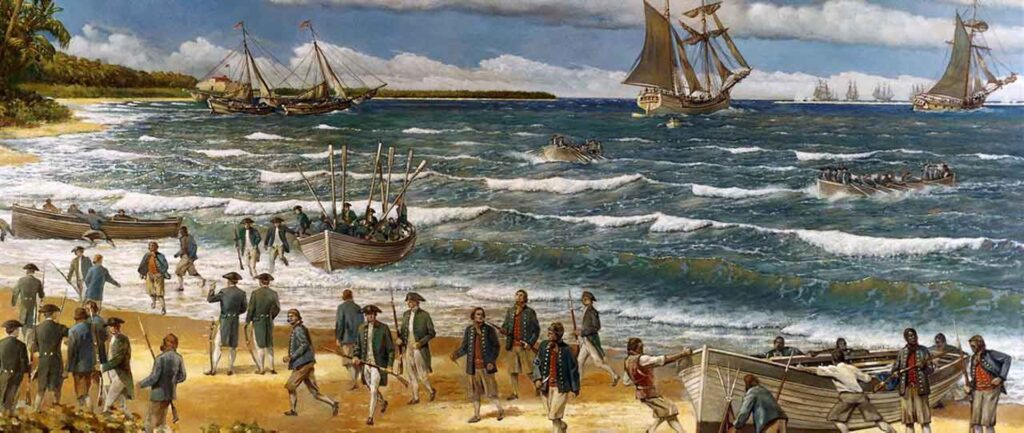
In August 1718, a new governor, Woods Rogers, a former privateer, arrived in Nassau. He brought with him a royal proclamation offering amnesty in exchange for an end to piracy. Out of a thousand pirates, six hundred obeyed and the rest scattered. Captains Benjamin Hornigold and Henry Jennings bowed their heads and accepted the King’s pardon.
Charles Vane disobeyed. He filled the captured French merchant ship with barrels of gunpowder and oil, turning it into a floating bomb. At night he lit fuses and aimed this ‘bomb’ at the warships. The explosion and fire turned the bay into daylight. On his fast-moving brigantine, Vane left the harbor, firing cannons at the Governor’s ships, cursing him and promising to return.
To combat piracy, Governor Woods Rogers needed experienced captains. He invited Hornigold and Jennings to join him. Not wanting to get involved in a showdown with his former cronies, Jennings refused and moved to Bermuda. There he lived comfortably on the treasure he had stolen. And Hornigold took up the Governor’s offer. He knew the local waters and the remote pirate bases on the islands and was successful in his searches. Captured pirates were hanged as an example to others. However, Hornigold’s ship was struck by a hurricane, a common occurrence in these waters. No one escaped.
What about the pirate Vane? He continued to plunder down the east coast of North America. During his raids, he captured many two-masted sloops and built a fleet, following the example of his friend ‘Blackbeard’. As captain of his pirate flotilla, Vane expanded his operations and became a real threat to the coastal waters of South and North Carolina, areas of heavy merchant shipping.
The people of Charleston lived in fear whenever they received news of another pirate attack. Vane completely paralyzed the port’s maritime trade, and today, centuries later, if you ask residents whether their city was named after King Charles of England or the pirate Charles, many will not get the right answer. The pirates challenged the balance of power and spread fear and panic.
In September 1718, Vane visited his mate nicknamed “Blackbeard” in North Carolina. Hiding their ships at the mouth of the Ocracoke River, the pirates spent a week drinking and celebrating another of Beard’s marriages. Vane learned much from his mate, including the ability to use his authority to keep others in line. He was adamant in his decisions, but disregarded pirate rules and often cheated in the division of booty. According to his companions, Vane had no honor and was not trustworthy. His despotism put pressure on them and they fled with their ships at the first opportunity.
Vane continued his raids alone, on his “Ranger.” One day, in the waters of New York, he tracked down another victim. As they approached the ship, Vane hoisted a black flag on the mast of his schooner, as he always did, expecting unconditional surrender. Instead, French flags flew up on the ship and cannons rumbled their fire on pirates. It turned out to be a warship, and the French rushed to the attack. Vane decided not to engage. The pirates managed to escape, aided by the fog. According to pirate law, during a battle, chase, or pursuit, the decision rested with the captain, but the next day a council was held, and the pirates were divided. Vane justified his decision to avoid a battle because the French ship’s guns were vastly superior to those of the ‘Ranger’, which would have been blown to pieces by the French cannon bolls.
Quartermaster Jack Rackham, second only to the captain in the pirate hierarchy, added fuel to the fire:
“Even if they had more cannon,” Rackham pounded his fist on the table, “we should have boarded them! And may this day belong to the brave men!”
The pirates murmured in agreement. Vane was reminded of all his grievances and dismissed from his post. A former friend, Rackham, who had always envied Vane, was made captain of the ‘Ranger’ and was now his enemy. Vane was given a small sloop and an offer to leave. Some of the crew, agreeing with his decision, left with their captain.
Vane sailed to the little-explored waters of the Gulf of Honduras. There he quickly settled in and continued to plunder and sink ships. The pirate would hide in secluded bays and launch his raids from there. He was cleaning and tarring the bottom of his sloop on islands protected from pursuit by reefs and shallow waters. He would hide some of his booty there and be pleased with himself. But one day the pirate’s luck ran out.

This time Vane was a victim not of human passion but of the elements. In February 1719, a hurricane wrecked his pirate sloop in the shallows of Lighthouse Atoll. The entire crew perished, leaving Vane and one of his sailors alive. They were surviving making a fire from the wreckage of their sloop to fry fish. A month later, a passing ship came to the island to replenish their water supply. The ship’s captain, Holford, acknowledged his former friend, from whose tyranny and treachery he had fled. He now set Vane a condition:
“I am going on my own business and will be back in a month. The reason I won’t take you on board is that you’ll make a mess of the crew, crack my skull one night, and take my ship.”
Holford added:
“And if I catch you here, I’ll take you in chains to Jamaica, where you, Vane, will be hanged!”
“Do I have a chance?” Vane grinned crookedly in reply.
“Oh yes, there’s always a chance,” Holford replied, “there are fishing boats here!
“Are you suggesting that I steal a fishing boat?” Vane laughed.
“Oh, perhaps you have grown a conscience? You, who have been a robber and a pirate all your life, stealing ships and cargo and robbing everyone in your path? Stay here if you have become such a coward!”
With these words, Holford hoisted the sails and sailed his ship out to sea.
The days dragged on, and one day another ship came to the island to replenish the supply of fresh water. None of the crew knew Vane, and he managed to convince the captain that he and his companion were victims of a hurricane that had blown their merchant ship to pieces on the reefs. So Vane and his sailor found themselves on board. The pirate’s spirits were high and he was hatching a cunning plan when the unexpected happened. They encountered Captain Halford’s ship at sea, returning to Jamaica.
The captains knew each other, and Halford was invited to dinner. Walking across the deck to the captain’s cabin, Holford looked into the hold and recognized Vane in one of the sailors.
He immediately warned his colleague that he had one of the most egregious scoundrels on board and that his life was now in danger. The captains came to an understanding and Holford soon returned with armed sailors who captured and chained the pair.
In March 1720, Charles Vane and his mate were tried and hanged at Port Royal, Jamaica.
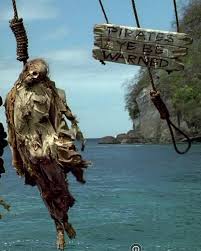
EPILOGUE.
What became of Rackham, who once stole a ship from Vane? Driven out of Bahamian waters by Governor Woods Rogers, he hid for a time in Cuba, where the Spaniards drove him out. A worthless strategist, he was nothing more than a petty bandit, robbing fishermen’s boats and stealing cattle from farmers. He was finally captured and hanged with his associates in Jamaica at the end of the same year, 1720.
In 1715, when a hurricane destroyed 12 Spanish fleet ships carrying New World treasure back to Spain, the pirates attacked the salvage camp and made off with gold, silver, and jewelry worth £87,000 at the time. It was the largest pirate haul of the time! Much of the jewelry was for the Spanish royal family and had been crafted by master jewelers with great care and an abundance of precious stones.
Vane, who had a share of these treasures, never parted with them and kept his chest with him at all times. This precious chest still lies in the shallows of Lighthouse Atoll in Belizean waters, the remains of the pirate’s sloop have never been found…
© Copyright №214040902223
5. THE DEVIL CALLED ‘BLACKBEARD’.
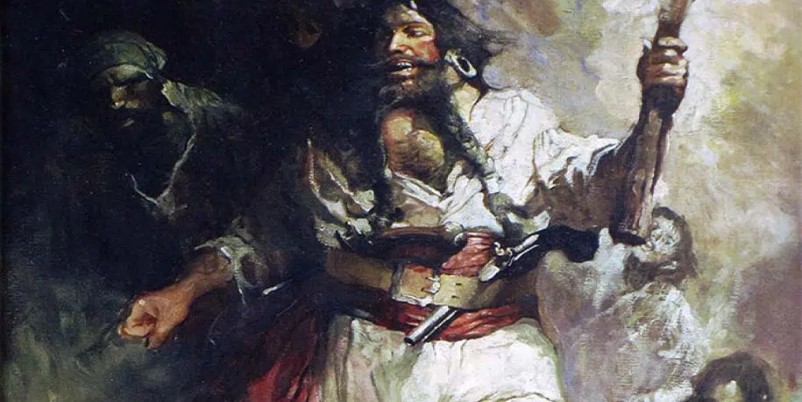
I once met a distant ancestor of a pirate nicknamed ‘Blackbeard’ on the pier of our fishing village. This amorous pirate had 15 wives, and today his descendants probably number in the hundreds, with grandchildren and great-grandchildren scattered across the Caribbean islands and the coasts of North and Central America.
My new acquaintance was from the Marine Patrol. On their small boat, I saw impressive machine guns on turrets, and the crew members were armed with heavy pistols strapped to their legs. When I asked why they were so armed, I was told that there were still a lot of pirates in the Caribbean and that they were mainly involved in drug trafficking.
I was also told that an average of a dozen private yachts go missing every year in the Caribbean, including the waters of the Bahamas and Bermuda, and are never found. Perhaps many of them fall victim to pirates who use them for a trip and then send them to the bottom of the sea with their owners.
Blackbeard’s ghost still seems to hover over the masts…
***
It is said that a holy place is never empty. But I think even in hell all seats are booked in advance. An English sailor from Bristol, Edward Teach, nicknamed ‘Blackbeard’, was known as a cruel and cunning pirate. Beginning his career as a mate in 1715, Teach was soon given command of a two-masted brig by his mentor, Benjamin Hornigold. The pair plundered every ship from Havana to New York, roaming the coasts of Florida, South and North Carolina, Bermuda, and the Bahamas in search of prey.
Huge in stature, of immense physical strength, covered with hair like a wild animal, with a long black beard covering his face, Teach was armed with pistols, sabers, and knives. This beast in human form was unpredictable in his antics, which terrified everyone, including his accomplices.
Once, off the island of St. Vincent, he managed to seize a French brig that was sailing from Africa to Martinique. The ship was full of gold, jewels, and black slaves. Teach was Hornigold’s mate at the time, and for such a rich prize, Hornigold gave the brig to the mate. ‘Blackbeard’ fitted his new ship with cannons and named it ‘Queen Anne’s Revenge’. It seems that the pirate was well aware of the history of his native England. The bloodiest deeds are always committed by the most educated individuals.
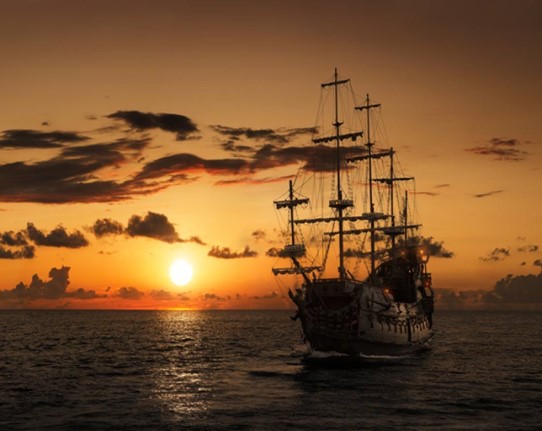
***
In July 1718, King George I of England sent a new governor to the Bahamas, a former privateer, Woods Rogers, a brave navigator who had sailed around the world. Sir Woods Rogers arrived in Nassau with three warships and a royal amnesty for those who agreed to give up the pirate trade. For those who refused, he offered the gallows.
One of the most famous pirates, Benjamin Hornigold, agreed to quit, received a royal pardon, and retired. Many other pirates followed his example.
But ‘Blackbeard’ continued to pirate alone. With three hundred brigands on board, he set sail for the Gulf of Honduras, in the area of the busiest Spanish trade routes. Ships carrying plunder from Honduras, Guatemala, Venezuela, and Colombia passed through these waters on their way to Havana.
At sea, Blackbeard encountered Captain Bonnet’s ten-gun ship. This Bonnet was a stranger in piracy; he had little knowledge of the dangerous trade and no experience. ‘Blackbeard’ invited Bonnet to join him, renamed his ship as ‘Revenge’, and put his experienced captain Richards in command. And to Bonnet, he gave a comfortable cabin full of liquor.
In the space of a few months, they robbed 20 merchant ships, terrorized the local population, and disrupted shipping in the region. One day the pirates were replenishing fresh water at Turneffe Atoll when they spotted a sail on the horizon. Captain Richards chased them down in his brig and seized the ship. ‘Blackbeard’ made the ship the third in his pirate fleet, jokingly calling it ‘The Adventure’.
The trio sailed south and found several merchant ships anchored off one of the ports in Honduras. ‘Blackbeard’ decided to attack at once. Unfurling pirate flags from their masts and firing their cannons, the pirates rushed to attack. Swinging their sabers, they threatened to cut off the ears of anyone who resisted. The sailors of the merchant ships jumped into their dinghies in fear and beat the water with their oars. Those who had no time to escape surrendered. The pirates looted the ships, burning and sinking two of them. ‘Blackbeard’ offered the captives a choice – jump overboard and negotiate with sharks in the water or roast in the fire. He let the ship from Jamaica, taking everything of value on board.
That night, the pirate drank with his pals. His favorite drink was rum with raw pigeon eggs and gin. He laced this hellish cocktail with gunpowder.
“I won’t drink this explosive filth,” said the tipsy pirate, slurring his words.
‘Blackbeard’s owlish eyes popped out of their sockets and his braided locks smoked:
“Well, if you won’t drink my powder,” he grinned, “then you’ll have to sniff it!”
With that, Teach blew out the candle and discharged two of his pistols under the table, drowning out the wounded man’s wild screams with his laughter. By shooting his drinking companion in the knee, he crippled him for life. When the crew asked him why he had done this, ‘Blackbeard’ barked that if he did not kill the man who disobeyed his orders today, the crew would forget who he was tomorrow.
***
After raiding a dozen more merchant ships along the way and filling their holds with loot, the pirates headed for the American coast. In South Carolina, they terrorized the people of Charleston by blockading the harbor and seizing several merchant ships. ‘Blackbeard’ demanded medicine from the city officials, threatening to send the severed heads of the captives and burn all the ships in the harbor if they refused.
To the thunderous silence of the townspeople, the pirate delegation marched through the streets of the town to the governor’s house. After receiving the chest containing their demands, the pirates retreated to their boats and left for their ships.

They sailed to the coast of North Carolina to sell their booty. The governor there was on friendly terms with a pirate and buying the loot from him. All valuable cargo was always aboard the flagship, and ‘Blackbeard’ kept the other two ships light so they could keep up a good speed in pursuit of the next prey once on the horizon.
Along the way, the pirate decided to keep all the loot for himself. Knowing the local waters well, he lured his companions’ ships onto the reefs with deceptive courses. Left alone, ‘Blackbeard’ abandoned some of his comrades on a deserted island, where they starved to death.
The governor of North Carolina informed him that the amnesty granted to the pirates by royal proclamation was about to expire. After completing the necessary formalities, the pirate received an official document granting him pardon and the right to own the brig.
The pirate was oppressive with women and would not forgive anyone who resisted his advances. One girl refused him because she was engaged to a sailor. And she showed him a ring as proof. One day, ‘Blackbeard’ seized a ship and noticed the same ring on the finger of one of his captives. After cutting off the wretched man’s hand, he sent the girl a “gift” in the same silver box in which she had given the ring to her lover. The unfortunate woman died of mental anguish.
In North Carolina, ‘Blackbeard’ staged another orgy wedding, taking another 16-year-old girl as his wife. The ceremony was performed by Governor Charles Eden himself, and after the first wedding night, the pirate gave the young woman to five companions, who raped her in his presence. After enjoying the spectacle, the pirate sailed to Bermuda, where he robbed several merchant ships laden with sugar and cocoa. Returning to North Carolina, he split the spoils with the governor, an accomplice in his dark dealings. Officials in the governor’s inner circle, realizing that the pirate’s criminality had gone too far, secretly appealed to the authorities in neighboring Virginia for help.
***
YOU MUST KILL HIM!
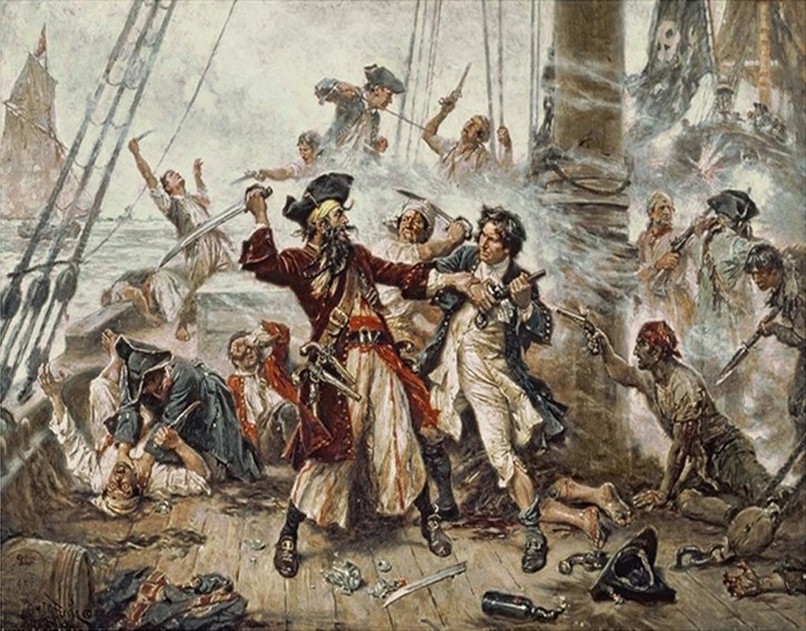
At the end of October 1718, Naval Lieutenant Robert Maynard was called before the Governor:
“Lieutenant, you have a reputation as a brave and intelligent commander,” the governor said, looking the lieutenant straight in the eye. “You have a dangerous mission ahead of you, we can only trust a man like you. But your enemy is not just a pirate, he is an animal. He is dangerous because he is clever enough to hide his dirty deeds in the administration of the neighboring state. He must not be apprehended and brought to justice, for his discrediting of government officials could have unpredictable consequences among the people. The governor paused.
He took a few steps around the cabinet and continued:
“In the name of the people of Virginia, I authorize you, Lieutenant Maynard, to kill the pirate at once. He is dangerously alive.”
The lieutenant listened to the governor:
“Sir, you do me the honor of commissioning this operation. I will carry it out.” Maynard smiled at the corners of his lips and asked to discuss the mission in detail.
“Thank you, Lieutenant. I did not expect a different answer,” the Governor offered Maynard a chair and a cigar.
On 17 November, three warships secretly left Virginia waters and within days were at the mouth of the Ocracoke River. Finding Blackbeard’s brig in the backwaters, the ships blocked the sea passage. All fishing schooners coming up the river were detained to prevent them from spying for the pirates. But ‘Blackbeard’ had already received a message from his buddy, the governor of South Carolina. The pirate was so sure of his impunity that he ignored the danger and stayed up all night drinking with his pals.
Early in the morning, Maynard’s ship maneuvered into the mouth of the river and approached the pirate’s brig. ‘Blackbeard’ watched the maneuver, knowing that the deep-water warship was about to run aground and become a target for his guns. But the pirate did not know that Maynard had wisely removed all the heavy guns from the deck and ballast of the ship. Now the ships were within musket shot of each other:
“Who the devil are you,” cried the pirate, “and where have you come from? I see you’ve got a king’s mattress on your bones. Come here and I’ll make you eat the buttons off your uniform,” he taunted to the wild laughter of his pirates. The shots from their muskets reinforced his threats. “I’ll be damned if I’ll spare you! ‘Blackbeard’ swallowed the whole mug of rum. His cannon fired shrapnel into Maynard’s ship, killing and wounding many.
The lieutenant ordered his men to take cover below. He remained alone on deck, giving orders to the helmsman. The second ship arrived in time, and its sailors’ muskets silenced ‘Blackbeard’s’ fury, thoroughly clearing the ranks of the pirates aboard his brig. Now the pirate was down to two dozen men.
Maynard’s reply was short:
“You can see by our flags that we are not pirates. I ask for no mercy and will not give it, I have orders to cut off your head”. With that, the lieutenant tasted the blade of his saber with his nail and gave the order for boarding.
Maynard had the same number of men left, so they were on equal footing. The boarding hooks dug into the pirate brig, and through the powder smoke ‘Blackbeard’ shouted:
“Come on, my pirates, let’s cut them all to pieces!”.
A bloody meat grinder began on the deck of the pirate brig. Maynard and Blackbeard fought to the death. ‘Blackbeard’ received twenty knife wounds and five gunshot wounds, but no bullets could take him, he was the devil himself! At the critical moment, Maynard’s saber broke, and the lieutenant was on the verge of death. One of the mortally wounded sailors held out his saber to him. A stroke of the blade ended the battle. ‘Blackbeard’ was dead.
The pirate’s decapitated body was dragged across the deck as a warning to the others and thrown overboard for the crabs to eat. Seeing the gruesome end of their idol, the pirates surrendered and begged not to be killed. The severed head of the bloodiest of them, nicknamed ‘Blackbeard’, was hung from the bowsprit of Lieutenant Robert Maynard’s flagship, and the trophy of the expedition was delivered to Virginia. The pirate’s accomplices were tried and all were hanged in Williamsburg, Virginia.
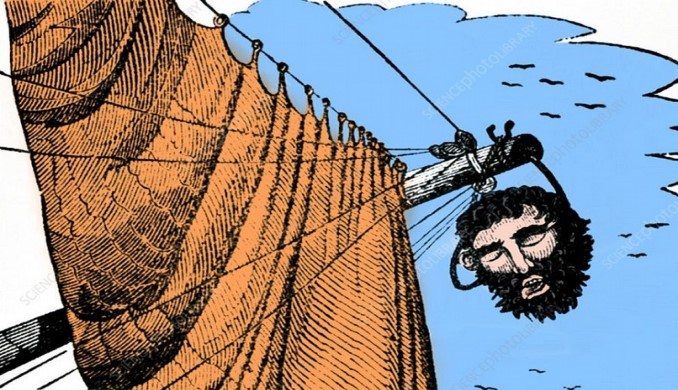
BLACKBEARD’S HIDDEN TREASURES.
One day, over a friendly drink, a companion asked the pirate where he had hidden his stolen treasure. Blackbeard grinned and said it was a secret between him and the devil, and that the last pirate would find his treasure.
Turneffe Atoll, where the pirate replenished his fresh water supply, lies in Belizean waters and consists of a dozen small islands covered in mangroves and palm trees. There, in hidden coves, the pirates cleaned and tarred the bottoms of their schooners. From the hills, they watched the horizon for the sails of their next prey…
One of the atoll’s islands is marked on maps as ‘Dead Man’s Caye’. On such deserted islets, far from the mainland, pirates would throw their comrade caught in cowardice, theft, or deceit, condemning the guilty to a slow, starving death.
The neighboring island is called ‘Blackbird Caye’ on modern maps.
Originally this island was called ‘Blackbeard Caye’. There was a base there, the lair of the beast. Later a grammatical error was made in the name, or the cartographers changed it to a politically correct one.
Blackbeard took the plundered treasure deep into the island. The captain himself carried a chest of gold and the sailor a shovel. The pirate would choose a suitable spot and while the sailor dug the hole, he would sit nearby and smoke his pipe. He would then finish off the sailor and bury the chest containing the treasure in the hole, along with the body of the man he had killed. When ‘Blackbeard’ returned, he told the crew that the missing sailor was stuck in the swamp and had been eaten by crocodiles.
Blackbeard was killed, taking the secret of his treasure to his grave. Ships wrecked by hurricanes and burned by pirates lie in the coastal waters of Turneff Atoll, and the islands of the atoll hold many secrets for those who seek treasure. The Devil was the only witness to where the pirate buried the gold, hoping to return for it one day…
© Copyright №214040900200


This article offers a fascinating perspective on the subject. The depth of research and clarity in presentation make it a valuable read for anyone interested in this topic. It’s refreshing to see such well-articulated insights that not only inform but also provoke thoughtful discussion. I particularly appreciated the way the author connected various aspects to provide a comprehensive understanding. It’s clear that a lot of effort went into compiling this piece, and it certainly pays off. Looking forward to reading more from this author and hearing other readers’ thoughts. Keep up the excellent work!
Great article! I found your perspectives on this topic both enlightening and thought-provoking. The way you break down complex ideas into understandable insights is truly commendable. It’s interesting to see how these developments could shape our future. I’m particularly intrigued by your point about potential challenges and would love to dive deeper into that.
For those who are interested in exploring this topic further, I recommend checking out this resource for more detailed information: a comprehensive guide. It offers additional insights that complement what’s discussed here.
Looking forward to hearing others’ thoughts and continuing this discussion. Thanks for sharing such valuable information!
Great article! I appreciate the clear and insightful perspective you’ve shared. It’s fascinating to see how this topic is developing. For those interested in diving deeper, I found an excellent resource that expands on these ideas: check it out here. Looking forward to hearing others’ thoughts and continuing the discussion!
I really enjoyed this article. The analysis was spot-on and provided a lot of food for thought. It would be great to discuss this further. What did you all think?
Real good information can be found on this website.
Wonderful perspective! The points you made are very enlightening. Excited to hear your views!
Your style is so unique compared to other people I’ve read stuff from. Thank you for posting when you have the opportunity, Guess I’ll just bookmark this page.
Great info. Lucky me I came across your blog by chance (stumbleupon). I have saved it for later.
Everything is very open with a precise description of the issues. It was really informative. Your site is very useful. Thanks for sharing!
I needed to thank you for this excellent read!! I absolutely enjoyed every bit of it. I have you book marked to check out new stuff you post…
Hello there! I simply wish to offer you a huge thumbs up for your excellent info you have here on this post. I will be coming back to your blog for more soon.
Oh my goodness! Incredible article dude! Thanks!!
Very good post! We are linking to this particularly great content on our website. Keep up the good writing.
I used to be able to find good information from your content.
Spot on with this write-up, I absolutely think this web site needs a lot more attention. I’ll probably be back again to read more, thanks for the info!
Aw, this was an incredibly nice post. Taking a few minutes and actual effort to make a top notch article… but what can I say… I procrastinate a lot and don’t seem to get anything done.
Hi, I do think this is a great blog. I stumbledupon it 😉 I’m going to return once again since i have saved as a favorite it. Money and freedom is the best way to change, may you be rich and continue to guide others.
Very good information. Lucky me I ran across your website by accident (stumbleupon). I’ve saved it for later!
Wonderful post! We are linking to this particularly great post on our website. Keep up the good writing.
I wanted to thank you for this good read!! I definitely loved every little bit of it. I have got you book-marked to look at new things you post…
Right here is the right blog for anyone who hopes to find out about this topic. You know a whole lot its almost tough to argue with you (not that I actually will need to…HaHa). You certainly put a fresh spin on a topic which has been discussed for ages. Great stuff, just great.
Pretty! This was an incredibly wonderful post. Many thanks for supplying this information.
I would like to thank you for the efforts you’ve put in writing this site.
I couldn’t refrain from commenting. Very well written!
This website was… how do I say it? Relevant!! Finally I’ve found something which helped me. Kudos!
You should be a part of a contest for one of the greatest blogs online. I am going to highly recommend this web site!
Hello! I could have sworn I’ve visited this site before but after going through many of the articles I realized it’s new to me. Anyways, I’m certainly pleased I came across it and I’ll be book-marking it and checking back often.
I’m impressed, I have to admit. Seldom do I come across a blog that’s equally educative and amusing, and let me tell you, you have hit the nail on the head. The issue is something which not enough people are speaking intelligently about. I’m very happy that I stumbled across this during my hunt for something relating to this.
Hi there! This blog post could not be written any better! Looking through this post reminds me of my previous roommate! He always kept talking about this. I am going to send this article to him. Fairly certain he’s going to have a very good read. I appreciate you for sharing!
Excellent post. I will be experiencing many of these issues as well..
Great info. Lucky me I found your blog by accident (stumble upon). I have bookmarked it for later.
This is a topic that is close to my heart… Take care!
Great web site you have got here.. It’s difficult to find high quality writing like yours nowadays. I honestly appreciate people like you! Take care!!
Thank you so much!